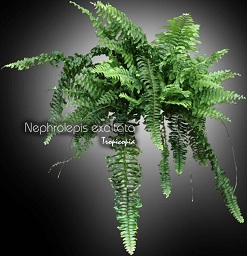Table of contents
Boston fern

Latin Name: Nephrolepis exaltata var.
Category: Fern
Family: Nephrolepidaceae
Origin: Cultivar
Climate: Tropical
Growing Zones: 11-10
Care Instructions
The Boston fern (Nephrolepis exaltata var.) is a tropical plant that originates from Cultivar. This fern plant belongs to the Nephrolepidaceae family and is well-suited for growing in USDA zones 11-10.
Complete Care Guide for Boston Fern (Nephrolepis exaltata var.)
Watering Requirements
The Boston fern thrives in consistently moist soil, making proper watering essential for its health. It is crucial to keep the soil evenly moist but not soggy. Water the fern when the top inch of soil feels dry to the touch. During the growing season, which typically spans from spring to early fall, you may need to water more frequently, possibly every few days, depending on the humidity levels in your environment. In winter, reduce watering slightly, allowing the soil to dry out a bit more between waterings. Always use room temperature water to avoid shocking the plant, and consider using distilled or rainwater if your tap water is high in chlorine or salts, as these can harm the delicate fronds.
Light Conditions
Boston ferns prefer bright, indirect light but can also tolerate low light conditions. Direct sunlight can scorch their delicate fronds, leading to browning and wilting. Ideally, place your fern near a north or east-facing window where it can receive filtered light. If you notice the fronds stretching towards the light, it may be a sign that your fern needs more light. Conversely, if the fronds are turning yellow, it may be receiving too much direct sunlight. If you are growing your Boston fern indoors, consider rotating the pot every few weeks to ensure even light exposure on all sides.
Soil Preferences
The ideal soil for a Boston fern is a well-draining, rich organic mix. A combination of potting soil, peat moss, and perlite or coarse sand works well to provide the necessary drainage while retaining moisture. The pH level should be slightly acidic to neutral, ideally between 5.5 and 7.0. Regular fertilization is not necessary, but during the growing season, you can feed your fern with a diluted liquid fertilizer every 4-6 weeks to promote healthy growth. Be cautious not to over-fertilize, as this can lead to salt buildup in the soil, which can harm the roots.
Pests and Diseases
Boston ferns can be susceptible to a few common pests, including spider mites, mealybugs, and scale insects. To identify these pests, look for webbing on the fronds (spider mites), cotton-like clusters (mealybugs), or small, hard bumps (scale). Regularly inspecting your plant and maintaining high humidity levels can help prevent infestations. If you do encounter pests, you can treat them with insecticidal soap or neem oil, ensuring to cover all surfaces of the fronds. Additionally, watch for signs of root rot, which can occur if the plant is overwatered or if the soil does not drain well. Symptoms include yellowing fronds and a foul smell from the soil. If root rot occurs, remove the plant from its pot, trim away any rotten roots, and repot it in fresh, dry soil.
Special Care Tips
To keep your Boston fern healthy and thriving, consider the following special care tips. First, maintain high humidity levels, as Boston ferns naturally grow in humid environments. You can achieve this by misting the fronds regularly, placing a humidifier nearby, or setting the pot on a tray filled with pebbles and water (ensuring the pot does not sit directly in the water). Additionally, avoid placing your fern near heating vents or air conditioning units, as these can dry out the air. Pruning is also beneficial; regularly trim away any dead or yellowing fronds to encourage new growth and maintain the plant’s appearance. Lastly, if you notice your fern becoming leggy, consider repotting it into a slightly larger pot to give the roots more space to grow. With these care tips, your Boston fern can flourish and add a lush, green touch to your home or garden.








